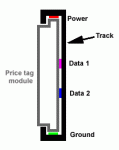Hi, I'm interested in using 1000s of LCDs to display in-store prices. I have several questions:
1) Can I use a single computer, hooked to a switching board to communicate with each LCD board in turn to update the information on the LCDs?
2) As long as power is being driven to the board, will the current displayed text remain on the screen. i.e. if I switch to a different LCD (per question 1), will the text remain on the last LCD, assuming I have a constant power source to all the screens?
Thanks.
1) Can I use a single computer, hooked to a switching board to communicate with each LCD board in turn to update the information on the LCDs?
2) As long as power is being driven to the board, will the current displayed text remain on the screen. i.e. if I switch to a different LCD (per question 1), will the text remain on the last LCD, assuming I have a constant power source to all the screens?
Thanks.
Looking for additional LCD resources? Check out our LCD blog for the latest developments in LCD technology.

